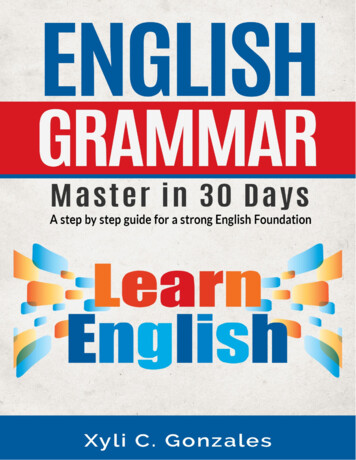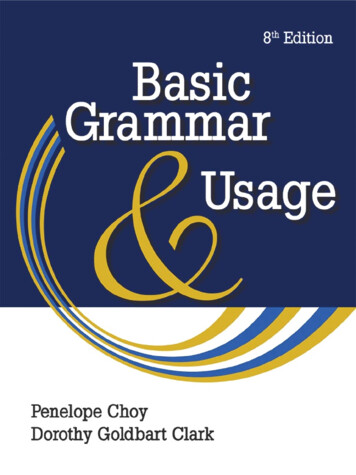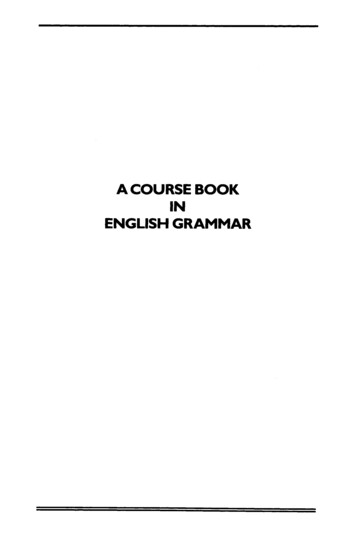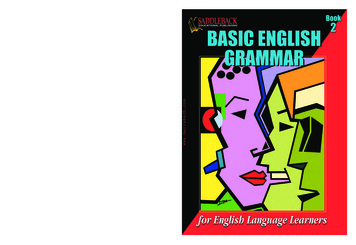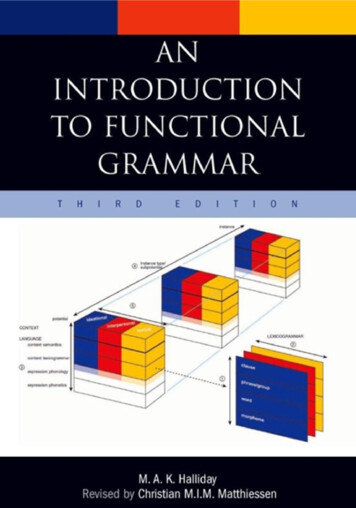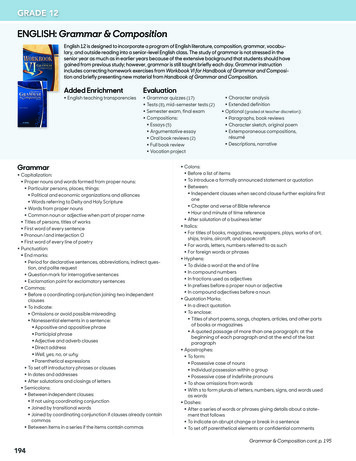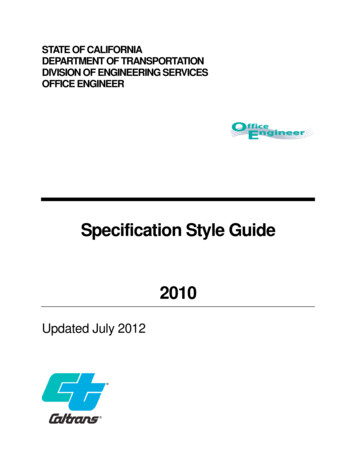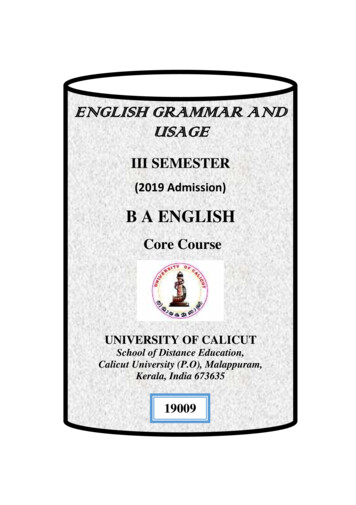
Transcription
ENGLISH GRAMMAR ANDUSAGEIII SEMESTER(2019 Admission)B A ENGLISHCore CourseUNIVERSITY OF CALICUTSchool of Distance Education,Calicut University (P.O), Malappuram,Kerala, India 67363519009
School of Distance EducationUNIVERSITY OF CALICUTSCHOOL OF DISTANCE EDUCATIONStudy MaterialIII SEMESTERB A ENGLISHCore Course ENG3 B042019 AdmissionENGLISH GRAMMAR AND USAGEPrepared by:Module 1 & 2: Smt. Smitha N,Assistant Professor of English(On Contract),School of Distance Education,Calicut University.Module 3, 4 &5: Smt. Nabeela MusthafaAssistant Professor of English(On Contract).School of Distance Education,Calicut University.Scrutinized by:Dr. Muhammed Noufal K.,Assistant ProfessorDepartment of EnglishCKGM Govt. College, Perambra.English Grammar and Usage2
School of Distance EducationContentsIntroductionModule 1Basic Grammatical Units:1. Form class and Function words2. IdentifyingtheGrammaticallabelsandFunctional labels of words.3. VerbinFunction–GerundsInfinitives,Participles – their uses4. Mood and Modality5. English Morphology6. Synonyms, Antonyms, Precise Use7. Phrasal VerbsModule 2The Sentence1. Word Order and Sentence Pattern2. Coordination and SubordinationModule 3Sentence Transformations: A Relook at TraditionalCategories1. Transformation of SentencesEnglish Grammar and Usage3
School of Distance Education2. Tag Questions3. Active and Passive Voice4. Direct and Indirect Speech5. Simple, Complex, Compound6. Collocation7. MovementModule 4Important Grammatical Concepts1. Time, Tense and Aspects2. Anomalous Finites3. Subject – Verb agreement in Sentences.4. Degree of ComparisonModule 5: Practical Exercises:1. Reorder jumbled sentences2. Correct the given sentences according to acceptedModern usage and justify the changes made3. Paragraph Editing (with more focus on grammaticalcorrections)4. Translate a passage from Mother Tongue to EnglishSources and ReferencesEnglish Grammar and Usage4
School of Distance EducationIntroductionThis course aims at preparing undergraduatestudents to learn how to use language with a properknowledge of the nuances of structure and usage ofEnglish language. It aims at a recapitulation of Englishgrammar and usage that learners would have acquired atthe lower levels. Part one of this SLM contains a studyof grammatical units. This section also deals withconcepts related to morphology, synonyms/antonymsand phrasal verbs. Part two modules 2 and 3 deal withsentences that too based on fundamental patterns.Further the discussion moves ahead with sentencetransformations such as active/passive/ direct/indirect/simple, complex and compound forms. Part four Module4 is a revisit into the specific features of language useinvolving tenses, concord, degrees of comparison andothers.Part five Module 5 is a section on compositionrelated to re- ordering of sentences, sentence correction,editing of paragraphs and translation. A few exercisesare also added for practice.English Grammar and Usage5
School of Distance EducationOBJECTIVES OF THE COURSE:a. To familiarize the students with the key concepts ofEnglish grammar and to use them more sensitively intheir day-to-day communication needs.b. To help students to equip with better language usethrough the understanding of the sentence patterns inEnglish.c. To help the students develop a sense of Englishgrammar, idioms, syntax, semantics and their usage.\English Grammar and Usage6
School of Distance EducationMODULE IBasic Grammatical UnitsIn this Chapter you will be introduced The basic concepts of ‘Grammar’ The terms labels, levels and functionBasic concept of grammarGrammar includes the rules that govern the waysentences are formed and words are used to makemeaning. Improving your grammar will make it easierfor your reader to understand your writing. Learningabout grammar will enable you to better understand thefeedback that you are given on your assignments.Grammar is the study of words, how they areused in sentences, and how they change in differentsituations. There are two different ways that languagehas been talked about in disciplines that focus on the useof language. We can talk about these differentEnglish Grammar and Usage7
School of Distance Educationapproaches to language as descriptive grammar vs.prescriptive grammar.Prescriptive grammar describes when people focus ontalking about how a language should or ought to be used.This approach assumes that the experts know how thelanguage works. They set out arbitrary rules and for howit should be used and for what should not be used(proscriptions), based on norms derived from a particularmodel of grammar.One way to remember thisassociation is to think of going to a doctor’s office.When a doctor gives you a prescription for medication, itoften includes directions about how you should take yourmedication as well as what you should not do whentaking your medication. In a similar way, a prescriptivegrammar tells you how you should speak, and what typeof language to avoid. This is commonly found in Englishclasses as well as other language classes, where the aimis to teach people how to use language in a veryparticular (typically described as ‘proper’ or ‘correct’)way.English Grammar and Usage8
School of Distance EducationDescriptive grammar, on the other hand, focuses ondescribing the language as it is used, not saying how itshould be used. Descriptive grammar does not deal withwhat is good or bad language use; forms and structuresthat might not be used by speakers of Standard Englishwould be regarded as valid and included. It is a grammarbased on the way a language actually is and not howsome think it should be. It is a record of the conventionsfollowed by the users. It explains with no sense of valuejudgement.Let me make it clear, here is an example of a form thatprescriptive grammarians believe to be wrong:Manu is older than her.Although the above form is used by actual speakers,prescriptive grammar considers it an example of badlanguage, in their view, the right form should be:Manu is older than she.Prescriptive grammarians believe that the word ‘than’ isused as a conjunction that should be followed by aEnglish Grammar and Usage9
School of Distance Educationsubject pronoun. The correct form according to thisapproach should be ‘he is older than she (is)’.However, according to descriptive grammar,since the above form is used by actual language speakersand writers, it should be included in the data and studied.The word ‘than’ in this analysis is viewed as apreposition, and for that reason, it can be argued that thesentence ‘Manu is older than her’ is also correct and that‘her’ in this case functions as the object of thepreposition.In order to understand grammatical analysis, It isnecessary to learn certain amount of terminology.TERMINOLOGYThe body of terms used with a particulartechnical application in a subject of study, profession, etc.In grammar, we have certain terms which are proposedto enhance clarity in understanding language. Primarily,let us divide them into three categories.English Grammar and Usage10
School of Distance EducationLEVELLABELFUNCTIONRegarding Levels the main categories are Sounds andWordsA few terminology in English language are;Abstract noun (the opposite of a concrete noun) thename of something which we experience as an idea, notby seeing, touching, etc. Examples: doubt; height;geography.An active verb form is one like breaks, told, will help(not like is broken, was told, will be helped, which arepassive verb forms). The subject of an active verb isusually the person or thing that does the action, or that isresponsible for what happens.Adjective a word like green, hungry, impossible, whichis used when we describe people, things, events, etc.Adjectives are used in connection with nouns ective clause another name for relative clause.English Grammar and Usage11
School of Distance EducationAdverb a word like tomorrow, once, badly, there, also,which is used to say, for example, when, where or howsomething happens.The main categories of levels e following are the labels in English terminology sitionInterjection.English Grammar and Usage12
School of Distance EducationSection OneForm classes and function wordsClass formation:-In English grammar, a word class is aset of words that display the same formal properties,especially their inflections and distribution. The term "word class" is similar to the more traditional term, partof speech. It is also variously called grammaticalcategory, lexical category, and syntactic category(although these terms are not wholly or universallysynonymous).There is no single correct way of analyzing words intoword classes.The form classes also known as content words or openclasses include:NounsVerbsAdjectivesAdverbsThe structure classes, also known as function words orclosed classes, include:English Grammar and Usage13
School of Distance ticlesOne Word, Multiple Classes"Items may belong to more than one class. In mostinstances, we can only assign a word to a word classwhen we encounter it in context. Looks is a verb in 'Itlooks good,' but a noun in 'She has good looks'; that is aconjunction in 'I know that they are abroad,' but apronoun in 'I know that' and a determiner in 'I know thatman'; one is a generic pronoun in 'One must be carefulnot to offend them,' but a numeral in 'Give me one goodreason.'"English Grammar and Usage14
School of Distance Education‘Form’ refers to the category labels we use for thebuilding blocks of grammar, i.e. word classes, phrases,and clauses. They have reasonably clear lexical meaning.Consider the following sentence: My daughter bought a completely uselesssmartphone over the summer.Scanning this sentence from left to right we can labeleach individual word as follows: my: determiner daughter: noun bought: verb a : determiner completely: adverb new: adjective smartphone: noun over: preposition the: determiner summer: nounEnglish Grammar and Usage15
School of Distance EducationFunction wordsIn linguistics, function word (also called functor)is a word that expresses a grammatical or structuralrelationship with other words in a They signal thestructural relationships that words have to one anotherand are the glue that holds sentences together. Functionwords are also called grammatical words that have littlelexical meaning or have ambiguous meaning, but insteadserve to express grammatical relationships with otherwords within a sentence. Function words are closed-classwords. Languages do not easily add new words to thisset. They are always relatively few and resistant tochange. They are lexically unproductive and aregenerally invariable in form. Thus they form importantelements in the structures of sentences. In traditionalgrammatical technology , both these form words andfunction words are known as Parts of Speech.Example for function words :Prepositions:of, at, in, without, betweenEnglish Grammar and Usage16
School of Distance EducationPronouns:he, they, anybody, it, oneDeterminers:the, a, that, my, more, much, either,neitherConjunctions:and, that, when, while, although, orAuxiliary:verbs be (is, am, are), have, got, doParticles:no, not, nor, asParts of speech : There are eight parts of speech in theEnglish language: noun, pronoun, verb, adjective, adverb,preposition, conjunction, and interjection. The part ofspeech indicates how the word functions in meaning aswell as grammatically within the sentence. An individualword can function as more than one part of speech whenused in different circumstances. Understanding parts ofEnglish Grammar and Usage17
School of Distance Educationspeech is essential for determining the correct definitionof a word when using the dictionary.1. NOUN: A noun is the name of a person, place, thing,or idea.E.g. man, Butte College, house, happiness. Nouns areoften used with an article (the, a, an), but not always.Proper nouns always start with a capital letter; commonnouns do not. Nouns can be singular or plural, concreteor abstract. Nouns show possession by adding 's’. Nounscan function in different roles within a sentence; forexample, a noun can be a subject, direct object, indirectobject, subject complement, or object of a preposition.The young girl brought me a very long letter from theteacher, and then she quickly disappeared. Oh my!2. PRONOUN: A pronoun is a word used in place of anoun.E.g. She, we, they, it.A pronoun is a word used in place of a noun. A pronounis usually substituted for a specific noun, which is calledits antecedent. In the sentence above, the antecedent forEnglish Grammar and Usage18
School of Distance Educationthe pronoun she is the girl. Pronouns are further definedby type: personal pronouns refer to specific persons xive pronouns are used to emphasize another nounor pronoun; relative pronouns introduce a subordinateclause; and demonstrative pronouns identify, point to, orrefer to nouns.E. g. The young girl brought me a very long letter fromthe teacher, and then she quickly disappeared.3. VERB: A verb expresses action or being.E.g. jump. is. write. becomeThe verb in a sentence expresses action or being. Thereis a main verb and sometimes one or more helping verbs.("She can sing." Sing is the main verb; can is the helpingverb.) A verb must agree with its subject in number (bothare singular or both are plural). Verbs also take differentforms to express tense.E.g. The young girl brought me a very long letter fromthe teacher, and then she quickly disappeared.English Grammar and Usage19
School of Distance Education4. ADJECTIVE: An adjective modifies or describes anoun or pronoun.E.g. pretty, old, blue, smartAn adjective is a word used to modify or describe a nounor a pronoun. It usually answers the question of whichone, what kind, or how many. (Articles [a, an, the] areusually classified as adjectives.)E.g. The young girl brought me a very long letter fromthe teacher, and then she5. ADVERBAn adverb is a word that modifies (describes) a verb (hesings loudly), an adjective (very tall), another adverb(ended too quickly), or even a whole sentence(Fortunately, I had brought an umbrella). Adverbs oftenend in -ly, but some (such as fast) look exactly the sameas their adjective counterparts.E.g. Tom Longboat did not run badly.Tom is very tall.The race finished too quickly.English Grammar and Usage20
School of Distance Education6: PREPOSITION: A preposition is a word placedbefore a noun or pronoun to form a phrase modifyinganother word in the sentence.E.g. by, with, about, until. (by the tree, with our friends,about the book, until tomorrow)A preposition is a word placed before a noun or pronounto form a phrase modifying another word in the sentence.Therefore, a preposition is always part of a prepositionalphrase. The prepositional phrase almost always functionsas an adjective or as an adverb.E. g. The young girl brought me a very long letter fromthe teacher, and then she quickly disappeared.7: CONJUNCTION:A conjunction joins words,phrases, or clauses.E.g. and, but, or, while, because.A conjunction joins words, phrases, or clauses, andindicates the relationship between the elements joined.Coordinating conjunctions connect grammaticallyequal elements: and, but, or, nor, for, so, yet.Subordinating conjunctions connect clauses that areEnglish Grammar and Usage21
School of Distance Educationnot equal: because, although, while, since, etc.Correlative Conjunctions are either.or, neither. nor,both.and, not only.but also, whether.or.E.g. The young girl brought me a very long letter fromthe teacher, and then she quickly disappeared.My uncle is not only a doctor but also a pharmacist.8: INTERJECTION: An interjection is a word used toexpress emotion.E.g. Oh! Wow! Oops!An interjection is a word used to express emotion. It isoften followed by an exclamation point.The young girl brought me a very long letter from theteacher, and then she quickly disappeared. Oh my!Practice Exercise1. Write short notes on a) Form Classb) Function wordsC) How do we differentiate formal labels andfunctional labels?English Grammar and Usage22
School of Distance Education2. II Write an original sentence or short text thatillustrate each of the following concepts. Underlineand label the following pertinent word(s) in yoursentence1. Noun 2. Pronoun 3. Verb 4. Adjective 5.Preposition 6. Adverb7. Conjunction (This will help you to begin with thediscussion in the next chapter.)Section 2Identifying grammatical labels and functionallabels of words.In this section you will be introduced to; The linguistic units relevant to the form andfunction level The categorization of nouns, verbs, adjectives,adverbs, pronouns, prepositions, conjunctions The basic features of phrases and clausesEnglish Grammar and Usage23
School of Distance Education The use of verb in function: gerund, infinitives,participles A brief discussion on mood and modality Illustration of English morphology Discussion on synonyms and antonyms Explanation of phrasal verbs and idiomsThis chapter will lead you to the core area of grammarstudy and help you to understand the elements ofgrammar that can be considered the foundation of theEnglish language.Label of words‘Form’ and ‘function’ are two extremely importantconcepts that you need to know about to fully understandhow grammar works.Form :-form is concerned with the description oflinguistic units in terms of what they are.Function :-function is concerned with the description ofwhat these linguistic units do.English Grammar and Usage24
School of Distance EducationForm’ refers to the category labels we use for thebuilding blocks of grammar, i.e. word classes, phrases,and clauses. Consider the following sentence:My son bought an absolutely useless car over thewinterScanning this sentence from left to right we can labeleach individual word as follows:my: determinerSon: nounbought: verban: determinerAbsolutely: adverbnew: adjectiveCar: nounover: prepositionthe: determinerWinter: nounEnglish Grammar and Usage25
School of Distance EducationAll the word class labels above are referred to asgrammatical form labels. Still talking about form, we canalso say that:‘my son’ is a noun phrase‘an absolutely useless car’ is also a noun phrase‘over the winter’ is a preposition phrase.In summary, when we are talking about form, we aretalking about structure. We can visualize structure usingwhat linguists call tree diagrams. For a at about ‘function’?English Grammar and Usage26
School of Distance EducationThis label is actually ambiguous: it can have a generalsense and a grammatical sense, which are oftenconfusing. Let’s look at the general sense first. They arealways relatively few and resistant to change. They arelexically unproductive and are generally invariable inform. Considering the sentence below;Luckily, the bus came very slowly.The word ‘luckily’ in this sentence is an adverb that hasa logical function; it signals that the speaker views whatfollows (namely the bus came very slowly) as good thing.‘Very’ in the adverb phrase ‘very slowly’ is also anadverb which works to intensify the meaning of theadverb ‘slowly’. So we can say that the word ‘slowly’ isan intensifier. This can be called a semantic function.Now let us look at the grammatical sense of ‘function’(grammatical function)Look at the word ‘luckily’ again, this time we can seethat its grammatical function is ‘adverbial’. Here‘luckily’ modifies an entire clause.English Grammar and Usage27
School of Distance Education‘Very slowly’ also has the grammatical function ofAdverbial, but in this case it modifies the verb ‘come’.Apart from Adverbial, other familiar grammaticalfunction labels are Subject, Object and Compliment(which includes Subject Complement and ObjectCompliment)The main classes of function words are determiner,pronoun, conjunction, prepositionHere are the linguistic units relevant to the form andfunction level:English Grammar and Usage28
School of Distance EducationFORMFUNCTIONWord ClassesSubjectNoun, adjective, verb,Predicatoradverb, determiner,Objectpronoun, PhrasesNoun phrase, adjectivephrase,adverbphrase,preposition phraseClausesMain clause, subordinateclause, relative clauseEnglish Grammar and Usage29
School of Distance EducationMain clauseA main clause is a group of words that contains a verband a subject which makes complete sense on its own.They are used in English grammar. A main clause canform a complete sentence on its own. They have asubject and a predicate which are the 2 main parts of asentence. A predicate adds information about the subject.Example of a main clause:In the following example, the main clause is underlinedwhile the subordinate clause is not underlinedThe girls fed the ducks before they walked around thelake"Subject and predicate: Every complete sentencecontains two parts: a subject and a predicate. The subjectis what (or whom) the sentence is about, while thepredicate tells us something about the subject.A subject is the person or thing that is doing an action,or the person or thing that is the focus of the sentence.Most of the time the subject comes at the beginning of aEnglish Grammar and Usage30
School of Distance Educationsentence; in that case it is very easy to identify it. Takethe example below:Mary likes to run at the public park.The predicate of the sentence is the part that containsthe action. It is the part of the sentence that is not thesubject, and includes all the descriptions of the actionand the objects that are affected by the action. Take thisexample:Mary likes to run at the public park.Count NounsLook around your bedroom and name some things youor your parents have had to purchase: your bed, dresser,socks, books, etc. All of these things are count nouns, ornouns that you can count. You can count the number ofbooks on your bookshelf or shoes in your closet. Youcan count the walls around your bedroom and theblankets on your bed.The simple rule to defining a count noun is this: If youcan make a noun plural, which means that we have morethan one of something, or if you can add a number inEnglish Grammar and Usage31
School of Distance Educationfront of the noun, you have a count noun. Let's look atsome examples:‘Katya ate five doughnuts’.In this sentence, we were able to add a number in frontof the noun (doughnut) and made it plural by adding an's.' Thus, 'doughnut' is a count noun.There are fifty candles on her cake.Because we are able to put a number in front of 'candles'and are able to make 'candle' plural, it is a count noun.The opposite of a count noun isUncount noun orgroup noun. Uncount nouns cannot be counted - youcannot add a number in front of them, and they cannot bemade plural. 'Water,' 'excitement,' 'anger,' and 'weather'are all uncount nouns. You can't have 'two excitements'or 'three angers.' You also can't use the word 'weathers.''Book,' 'dog,' 'chair,' and 'banana' are all examples ofcount nouns. (You can count them and make each ofthem plural.)English Grammar and Usage32
School of Distance Education'Information,' 'happiness,' 'music,' 'wool,' and 'air' are allnon-count nouns. (You can't count them or make themplural.)Concrete Nouns and Abstract NounsAll nouns fall into one of two categories: concrete nounsand abstract nouns.A concrete noun is a noun that can be identified throughone of the five senses (taste, touch, sight, hearing, orsmell). Consider the examples below:Would someone please answer the phone?In the sentence above, the noun phone is a concrete noun:you can touch it, see it, hear it, and maybe even smell itor taste it.What is that noise?Even though noise can’t be touched—and the noise mayeven be coming from several places—you can hear thenoise, so it’s a concrete noun.After his retirement, Mr. Bond pursued his dream ofphotographing rainbows.English Grammar and Usage33
School of Distance EducationRainbows is a concrete noun: they can be seen. Mr.Bond is also a concrete noun, but dream and retirementare not. These nouns are considered abstract nouns.We’ll discuss abstract nouns in more detail below.An abstract noun is a noun that cannot be perceivedusing one of the five senses (i.e., taste, touch, sight,hearing, smelling). Look at the examples below:We can’t imagine the courage it took to do that.Courage is an abstract noun because it cannot be seen,heard, tasted, touched, or smelled.Below are two more examples of abstract nouns incontext.Early paleontologists assumed that the small brainsof some dinosaurs indicated stupidity of the species.Higher education is strongly recommended.Common nouns are words used to name general itemsrather than specific ones. Go into your living room. Whatdo you see? A lamp, chair, couch, TV, window, painting,English Grammar and Usage34
School of Distance Educationpillow, candle – all of these items are named usingcommon nouns.Common nouns are everywhere, and you use them allthe time, even if you don’t realize it. Wherever you go,you’ll find at least one common noun. Street, closet,bathroom, school, mall, gas station, living room; all ofthese places are things, and thus they are common nounsYour name is a proper noun. A proper noun is thespecial word that we use for a person, place ororganization, like John, Marie, London, France or Sony.A name is a noun, but a very special noun - a propernoun. English proper nouns have special rules.We always use a Capital Letter for the first letter of aname or proper noun. This includes names of people,places, companies, days of the week and months. Forexample:They like Anu. (not They like anu.)I live in England.She works for Sony.English Grammar and Usage35
School of Distance EducationThe last day in January is a Monday.We saw Titanic in the Odeon CinemaA collective noun is a noun that represents a collectionof individuals, usually people, such as:a team (for example: eleven football players)a family (for example: mother, father and two children)a crew (for example: 100 sailors)Material noun can be defined as “Material Noun arenames of materials or substances out of which things aremade. Ex: gold, iron, silver etc.”Characteristics of Nouns Many nouns can be recognized by their endings.Typical noun endings include:r/-oractor, painter, plumber, writer-ismcriticism, egotism, magnetism, vandalism-istartist, capitalist, journalist, scientist-ment glish Grammar and Usage36
School of Distance supposition Most nouns have distinctive SINGULAR andPLURAL forms. The plural of regular nouns isformed by adding -s to the singular:However, there are many irregular nouns which do notform the plural in this way: The distinction betweensingular and plural is known asNUMBER CONTRAST. Wecanrecognisemanynounsbecause they often have ‘the’,‘ a’, or ‘an’ in front of them.English Grammar and Usage37
School of Distance EducationFeatures of rAs it has been noted, there are three categories: vizmasculine, feminine, neuter. Some English nouns showgender either through suffixation (with or without) or byhaving some other kind of gender differentiation:English Grammar and Usage38
School of Distance eGooseganderBullcowStaghindBachelorspinsterName that can be applied to both male and female are ofthe Common Gender: Child, baby, pupil, neighbor,parent, servant driver etc. All inanimate things are said tobe of the Neuter Gender: meadow, tree, table, pen, pencil,room, iron, chair, etc.Noun-CasesNOUN-CASES are another topic which comes underNOUN. The CASE of a noun tells us about the positionof that noun in a sentence. In English there are FIVECASES.English Grammar and Usage39
School of Distance EducationThey are: Nominative case Objective case (or Accusative case) Dative case Possessive case (or Genitive case) Vocative caseAll these five Cases have been explained in detail below.1. Nominative case:A noun is said to be in the Nominative case if it is thesubject of a verb. (SUBJECT is the person or the thingwho or which carries out the action of the verb in thesentence)Examples: Mr. Ram is an intelligent boy.Mr. Ram is a proper noun in Nominative case. The painter paints the portraits.The painter is a common noun in Nominative case. I am buying vegetables for my family.“I" is a pronoun in Nominative case.English Grammar and Usage40
School of Distance EducationThese examples carry another term "pronoun" which is aword used to represent a noun.For example:I, We, You, He, She, it and they are the seven pronouns.There are only seven pronouns. Only other variations ofthese seven pronouns are there. Those variations can beused in place of the nouns.The next one in the Noun-cases is:3. Objective case (or Accusative case): Nouns orpronouns are said to be in Objective cases if theyare the direct objects of verbs or if they are theobjects of preposition. (Direct object is theperson or the thing upon whom or upon whichthe action of the verb is carried out).Examples: I met your sister.“Your sister" is in objective case. The vendors sell mangoes.English Grammar and Usage41
School of Distance Education“Mangoes" is in objective case. The book is on the table.“Table" is in objective case.It is object of the preposition ‘on’. This is one of my policies.“Policies" is in objective case.It is object of the preposition ‘of’.The next one in the Noun-cases is:3. D
English Grammar and Usage 7 MODULE I Basic Grammatical Units In this Chapter you will be introduced The basic concepts of ‘Grammar’ The terms labels, levels and function Basic concept of grammar Grammar includes the rules that govern the way

